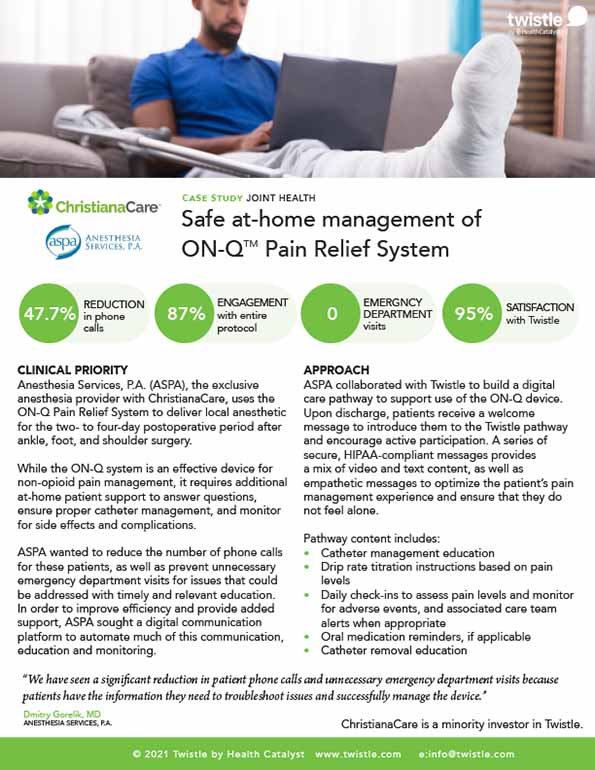Anesthesia Services, P.A. (ASPA), the exclusive anesthesia provider with ChristianaCare, uses the ON-Q Pain Relief System to deliver local anesthetic for the two- to four-day postoperative period after ankle, foot, and shoulder surgery. Read how ChristianaCare deployed Twistle to proactively answer questions and provide support, reducing phone calls by 47.7 percent.
Anesthesia Services, P.A. (ASPA), the exclusive anesthesia provider with ChristianaCare, uses the ON-Q Pain Relief System to deliver local anesthetic for the two- to four-day postoperative period after ankle, foot, and shoulder surgery.
While the ON-Q system is an effective device for non-opioid pain management, it requires additional at-home patient support to answer questions, ensure proper catheter management, and monitor for side effects and complications.
ASPA wanted to reduce the number of phone calls for these patients, as well as prevent unnecessary emergency department visits for issues that could be addressed with timely and relevant education. In order to improve efficiency and provide added support, ASPA sought a digital communication platform to automate much of this communication, education and monitoring.
ASPA collaborated with Twistle to build a digital care pathway to support use of the ON-Q device. Upon discharge, patients receive a welcome message to introduce them to the Twistle pathway and encourage active participation. A series of secure, HIPAA-compliant messages provides a mix of video and text content, as well as empathetic messages to optimize the patient’s pain management experience and ensure that they do not feel alone.
Pathway content includes:
"We have seen a significant reduction in patient phone calls and unnecessary emergency department visits because patients have the information they need to troubleshoot issues and successfully manage the device."
Dmitry Gorelik, MD
ANESTHESIA SERVICES, P.A.
A pilot program to test the efficacy of Twistle was sponsored by a sub-group of anesthesiologists within ASPA, who invited their patients undergoing ankle, foot and shoulder surgery to use Twistle.
The study analyzed resource use and complications for 46 patients who used Twistle; a total of 675 patients did not use Twistle.
“I liked the fact that someone was checking up on me and that if I had a question, they were there. It was extremely comforting.”
Patient
ENROLLED IN TWISTLE PATHWAY


